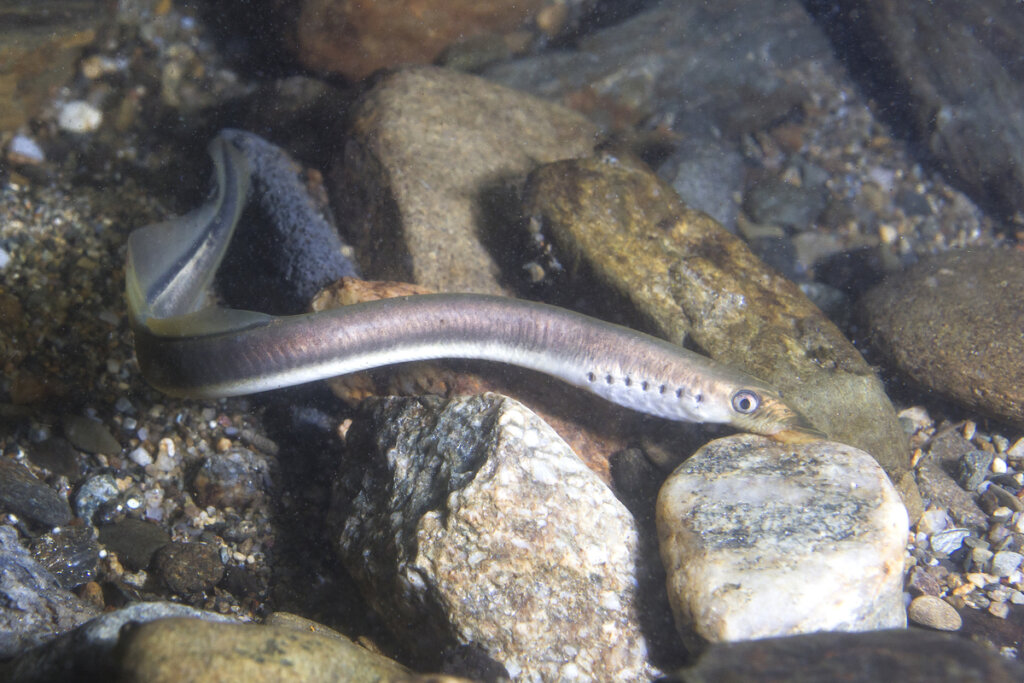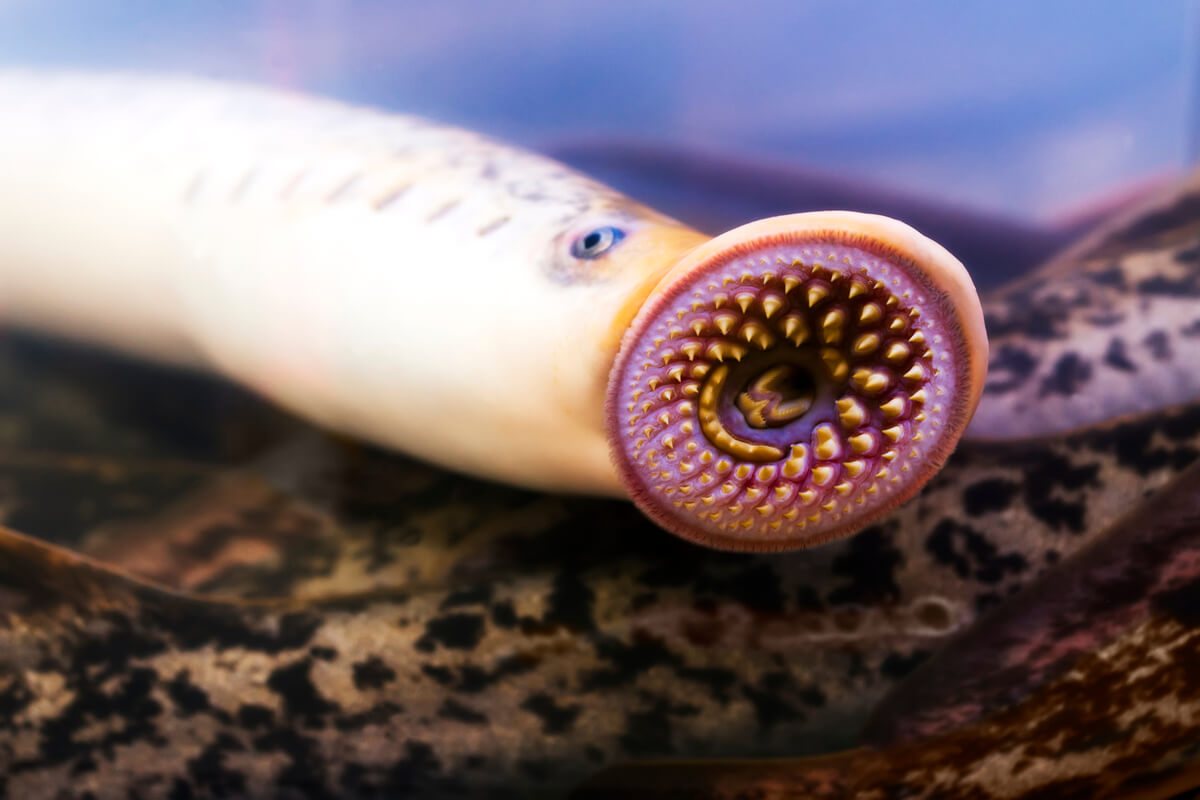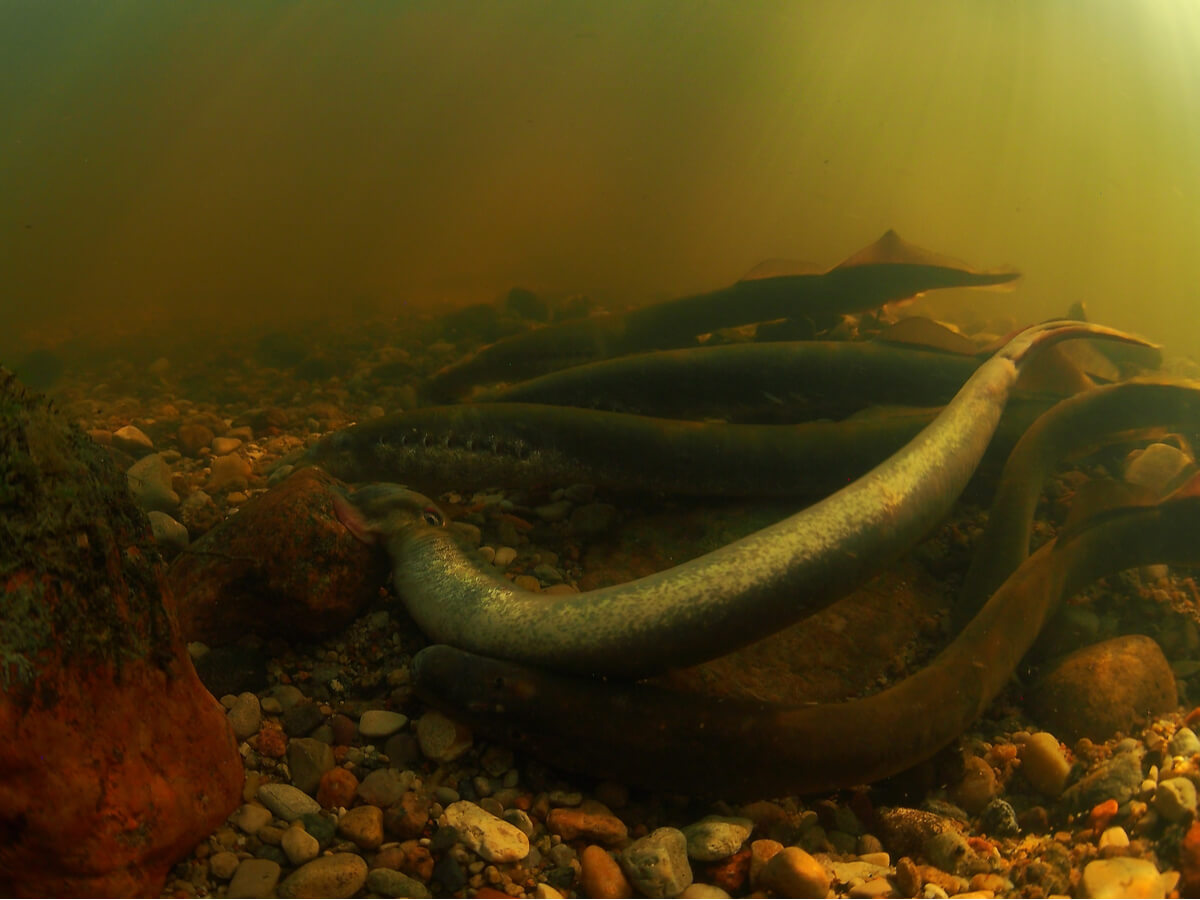Agnatha or Jawless Fish: Everything You Need to Know

This group of vertebrates gets its name for obvious reasons. Because there are many species that meet this and other characteristics, each of the organisms had to be classified into groups. Within all of them, the fish that make up the agnatha are characterized by being jawless fish, which seems to be an indication of their evolutionary past.
These fish first appeared about 470 million years ago. They ruled the land for a long time, as they were the only vertebrates at that time. At present, this group of jawless fish is very small, as most of the species are extinct and only lampreys and mixins remain. If you want to know more, keep reading.
What is an agnatha?
The term agnatha encompasses a biological group that brings together vertebrates that don’t have jaws. Its name comes from the Greek agnatha, “a” (without) and “gnatha” (jaws). According to the UNAM Institute of Biology, this taxon includes 108 current species and a large number of fossils.
Regarding their evolutionary history, agnatha are found just before the appearance of the mandible, but after the emergence of the notochord and the skull. They had great reproductive success in the Devonian period; however, by the end of that time they were drastically reduced.
Physical characteristics
The typical agnatha is an aquatic animal with primitive characteristics. Its mouth is circular, similar to a suction cup with teeth around it. These fish are capable of applying a suction force, which is sufficient to open wounds in the tissues of other animals. The physical form of the jawless fish resembles that of an elongated worm without scales, which can exceed a meter in length.
Their body is mostly cartilaginous, although some ancestors had skeletons and bony scales. The ostracoderms – extinct agnatha – even had bony shields or armor that allowed them to defend themselves. However, this defense wasn’t sufficient against the jawed fish, which is believed to be one of the reasons why they quickly disappeared.
What is a lamprey?
Quite similar to an eel, lampreys are species capable of occupying both fresh and salty waters. Their body is long, vermiform and flexible, which is why they manage to swim using wave movements, almost like those of a snake. They are mostly ectoparasites, as they anchor to their prey through their mouth, feeding on the animal’s blood or tissues.
Its mouth works like a real suction cup, with which the fish strongly adheres to its prey to feed. Its teeth allow it to tear the skin of its host and some species have a tongue capable of scraping tissues. In this way, the lamprey is able to feed, considering itself a threat to the ichthyofauna.
These bloodthirsty animals have a greater presence in the seas of the North Atlantic. They’re brown in color, with yellowish tones and dark spots. They can reach a length of 120 centimeters (4 feet), depending on the species.

Habitat of lampreys
These jawless fish have the ability to withstand saline and freshwater environments , although their life cycle encompasses both environments. They develop their adult life in the seas and return to the rivers to mate and reproduce, being defined as anadromous species. This term literally means ‘living in the sea, but returning to rivers to spawn’.
Lampreys are divided into marine or river lampreys, depending on which area the species spends the most time in. We’ll now take a short tour of each of these groups:
Marine lampreys
Among the species that spend most of their life cycle in the sea, we can find the following.
Chilean lampreys
At a scientific level, this species is known as Mordacia lapicida. It has a larval stage, during which it lives buried in the coast of rivers, migrating towards the sea in the winter season. Spawning usually occurs in late spring and early summer, in turbulent rivers.
This species is endemic to Chile and can measure up to 35 centimeters (14 inches) in length. It usually presents a condition called macrophthalmia, which refers to the abnormal growth of the eye.
Wide-mouthed lampreys
This type of lamprey stands out for having a bag of skin, which extends from the edge of the mouth to the first gill opening. This bag is more developed in males than in females. Their fins are pigmented and have various folds.
This bagged agnatha responds to the Geotria australis species, which undergoes a single reproductive process in fresh water, to later migrate to the sea and develop. It’s distributed in the fresh waters of southern Australia and in Chile.
River lampreys
Among the lampreys that spend the most time in fresh waters, we can find 2 species.
European brook lamprey
This organism doesn’t exceed 20 centimeters (8 inches) in length. It’s present in Europe, in medium-altitude rivers, coexisting with the common trout. It prefers small rivers, with moderate currents and little depth. Their mating takes place in late spring.
This lamprey (Lampetra planeri) isn’t a parasitic species. When it’s developing, it feeds on diatoms and other algae through filtration. However, upon reaching the adult stage, it no longer eats anything. It’s capable of living up to 7 years, but its larval period covers most of its life. It survives as an adult just over a month, long enough to reproduce.
European river lamprey
Lampetra fluviatilis is a species known for its preference to be carnivorous. It uses the teeth of its mouth to tear the tissues and feed on them, so it tends to attach itself to the areas with more muscle in the fish that it uses victims.
This species is nocturnal and prefers shallow, well-oxygenated areas. It usually inhabits cold waters with low or moderate currents. It’s distributed along the Atlantic coast of Europe and the Iberian Peninsula.
What are the hagfish, or slime eels?
The hagfish are the second group of agnatha that still exists. Its body shares several characteristics with lampreys. They’re elongated, with a shape similar to that of a snake; their skeleton is cartilaginous and they have only one tail fin. They don’t exceed 91 centimeters in length and have pores, which secrete a mucus that makes them more viscous.
The species of the group are hermaphrodites, so they have both testes and ovaries. Unlike lampreys, mixins are scavengers, so they only “gnaw” on the remains of dead animals. Their sense of taste works differently as they use papillae on their skin to taste food.
The mucus produced by the slime eels is their only means of defense. With it, they hope that the prey that has eaten them will vomit them up or drown.

Extinct jawless fish
This grouping of agnatha covers the group of ostracoderms. They were fish that had scales and a bony shield, which referred to bone plates that served as protection against predators.
Like the lampreys and the hagfish, the ostracoderms were jawless. To feed, they used muscular pumping, which allowed them to suck in water, trapping their prey in this process. In a way, they behaved like a filter, sucking in water and feeding on what came in.
They were freshwater organisms, which diversified over 150 million years. The jaw was born as a mechanism to deal with this group, as a way to “break” the bone shield was necessary to prey on them. This is one reason for their extinction, since ostracoderms didn’t find a way to defend themselves against gnathostomes – organisms with jaws.
One of the reasons why the agnatha group didn’t disappear was because of its adaptation mechanism. They left their filtering habits and became parasitic species (lampreys) or scavengers (mixines), which gave them a new chance to survive before the appearance of the jawed species.

Jawless fish only serve to demonstrate the impact that natural selection has on living things. Despite being organisms with great evolutionary disadvantages, agnatha managed to survive by changing their life strategy. This analysis allows us to delve a little into the webs of time, to try to decipher a little about our planet’s past, and the organisms that lived on it.
All cited sources were thoroughly reviewed by our team to ensure their quality, reliability, currency, and validity. The bibliography of this article was considered reliable and of academic or scientific accuracy.
- RUIZ, A. B., FUENTES, J., & MANCERA, Y. J. M. Las lampreas, Petromyzontifor-mes: origen y evolución.
- Ruiz VH, 1993. Ictiofauna del río Andalién. Gayana zoología (Chile) 57 (2): 109-278
- Neira F J, 1984. Biomorfología de las lampreas parásitas chilenas Geotria australis y Mordacia lapicida. Gayana zoología (Chile) 48(1 – 2): 3 4
- Campos H., Ruiz V.; Gavilán J F.; Alay F., 1993. Pesci del fiume Bíobío. Pubblicazione di divulgazione VOL. 5:7-100.
- Doadrio, I. (2001). Atlas y Libro Rojo de los Peces Continentales de España. Dirección General de Conservación de la Naturaleza, Museo Nacional de Ciencias Naturales, Madrid. 375 pp
- Hardisty, M. W., Potter, I. C. (1971). The Biology of Lampreys, vol. I. Academic Press, London. 423 pp.
- Hardisty, M. W. (1986). Lampetra planeri (Bloch, 1784). Pp. 279-304. En: Holcík, J. (Ed.). The Freshwater Fishes of Europe. Vol. 1. Part I. Petromyzontiformes. Aula, Wiesbaden.
- Tarlo, L. H. (1967). Agnatha. Geological Society, London, Special Publications, 2(1), 629-636.
- Märss, T., & Ritchie, A. (1997). Articulated thelodonts (Agnatha) of Scotland. Earth and Environmental Science Transactions of the Royal Society of Edinburgh, 88(3), 143-195.
- Denison, R. H. (1961). Feeding mechanisms of Agnatha and early gnathostomes. American Zoologist, 177-181.
